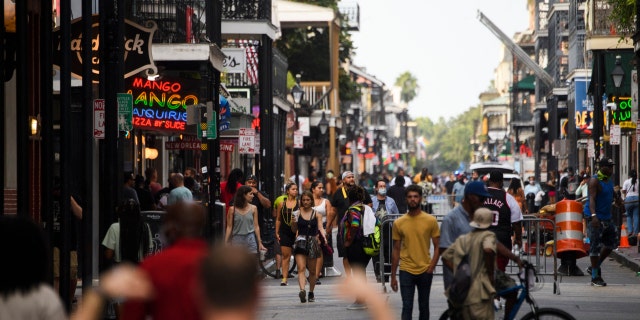NEWYou can now listen to Fox News articles!
There are certain U.S. cities that have consistently battled violent crime — particularly homicide — throughout the past three decades: Chicago, Philadelphia, Baltimore, even New York City.
Violent crime stories out of these beloved American cities frequently make news headlines due to local and national concern for their residents and the tourists who frequent these historic areas.
But perhaps more light needs to be shed on other cities in the South and Midwest that make national headlines less frequently than the aforementioned cities but have higher or comparable murder numbers per capita (or 100,000 residents), including New Orleans and Birmingham, Alabama; as well as Milwaukee; St. Louis; Cleveland; Rochester, New York; and Atlanta.
A compilation of June police data from cities with populations greater than 200,000 by AH Analytics co-founder Jeff Asher lists the top 31 U.S. cities with the highest murder rates, in order, so far in 2022.
SIX MAJOR CITIES ON PACE TO PASS HISTORIC 2021 VIOLENT CRIME TOTALS HALFWAY THROUGH 2021
On Asher’s list, New Orleans has a murder rate of 36.8 per capita so far this year, followed by Baltimore at a rate of 29.1; Birmingham at a rate of 29.1, St. Louis at a rate of 27.8, Milwaukee at a rate of 19, Cleveland at a rate of 16.9, Rochester at a rate of 16.6, Philadelphia at a rate of 15.1, Atlanta at a rate of 14.9, and Kansas City, Missouri at a rate of 14.6. These numbers only reflect murder numbers halfway through 2022 and are subject to change.
“I think … you can see a trend in increased violence across our country as a whole,” Alabama Fraternal Order of Police (FOP) President Everett Johnson told Fox News Digital. “…Birmingham, just based off the per capita [murders], I think that falls in line with what’s going on with the rest of our country … for the past two or three years.”
VIOLENT CRIMES ON THE RISE IN 2022, FOLLOWING PREVIOUS UNPRECEDENTED SPIKE IN MURDERS
In 2021, more than a dozen cities reported record homicide numbers, following a trend of violence that began in 2020.
For example, New Orleans recorded 145 murders as of June 30, putting it on pace for nearly 300 murders this year, which would put the city’s homicide rate at 74.12 per 100,000 population by the end of the year. That rate would dwarf Chicago’s 18.26 murders per 100,000 population, even though the Windy City recorded more murders in 2021 than it had in a quarter-century.
Among major U.S. cities, New Orleans currently has the highest murders per capita so far this year, according to June data complied by AH analytics.
(Michael DeMocker)
New Orleans would also rank 9th in homicides among major cities in the world that are not at war, according to 2018 data compiled by the Citizen Council for Public Security and Criminal Justice, a Mexico City-based advocacy group. New Orleans saw murders rise from 119 in 2019 to 201 in 2020. That number continued to climb in 2021, reaching 218, an 83% increase over 2019 numbers.
“I can’t speak for the country, but people in Louisiana certainly know it’s one of the…most dangerous cities,” Darrell Basco, president of the Louisiana FOP, said, adding that what they see on the news and “experience personally” when they visit the city has made Louisianans aware of the violence in New Orleans.
ATTORNEY GENERAL STOPS SHORT OF CALLING CRIME WAVE A CRISIS: ‘MATTER OF CONSIDERABLE CONCERN’
The Big Easy attracts “a lot of tourists” to Louisiana year-round, Basco said, adding that city council members and other elected officials need to partner with community organizations to get a handle on violence before it impacts tourism revenue.
Basco blamed part of the issue in both Louisiana cities on a “progressive-leaning” district attorney, difficulty attracting and retaining police officers, and “the demonization of police officers” — a trend that other major U.S. cities are also grappling with since 2020.

New Orleans saw murders rise from 119 in 2019 to 201 in 2020. That number continued to climb in 2021, reaching 218, an 83% increase over 2019 numbers.
(PATRICK T. FALLON/AFP)
Five miles north of New Orleans in Birmingham, Alabama, police have recorded 74 murders so far this year as of July 26, according to the Birmingham Police Department, putting the city’s murder rate at about 35 per capita for the city of more than 210,000.
JUVENILE CRIME HURTING YOUNG VICTIMS ACROSS MAJOR US CITIES: ‘A VICIOUS CYCLE’
“Based on my knowledge of Birmingham and similar cities, they have a very lenient bond process and pretty much a signature bond that let[s] you back out regardless of the crime. When violent offenders aren’t locked away, violence increases,” Everett Johnson, president of the Alabama FOP said. “…I think it’s a lenient bond system and a lenient criminal justice system. We currently in Alabama have a ‘good time’ law that allows offenders back on the street for serving so many days for good behavior, but I think that law is…being perverted.”
He also believes there is a cultural lack of “respect for human dignity and human life” in cities like Birmingham with high murder rates. There is also “a drug culture” of Birmingham residents trying to compete with one another that leads to violent crime, he explained.

Five miles north of New Orleans in Birmingham, Alabama, police have recorded 74 murders so far this year as of July 26, according to the Birmingham Police Department, putting the city’s murder rate at about 35 per capita for the city of more than 210,000.
(Isabella Pino/REDA&CO/Universal Images Group )
St. Louis is also high on the list of the most murders-per-capita in the country, but homicide trends have decreased so far in 2022 by 15% since 2021. St. Louis ranked No. 1 in murders per capita in 2020.
Aside from the decreasing homicides, aggravated assaults including firearms and other dangerous weapons, robberies and larcenies are also down as of this month, according to St. Louis government officials.
“One of the major spikes in non-violent crime not only locally but nationally has to deal with larcenies, many of them involving vehicles,” St. Louis Police Department Lt. Schellman said in a July 6 statement. “Larcenies in St. Louis County are down 7% overall. Much of this credit goes to the hardworking individuals of the St. Louis County Police Department. Our department is over 1,200 men and women, many working behind the scenes to keep our community safe.”
St. Louis County Executive Sam Page, Ph.D., attributed the success so far this year to police funding, saying in a July 6 statement that the county spends about $166 million per year on policing, which represents 48% of the general fund budget.

St. Louis is also high on the list of the most murders-per-capita in the country, but homicide trends have decreased so far in 2022 by 15% since 2021
(America/Education Images/Universal Images Group via Getty Images)
“This allows our department to offer highly specialized services that smaller communities cannot match,” Page said. “This includes the Bureau of Crimes Against Property, Bureau of Crimes Against Persons, Commercial Vehicle Unit, Highway Safety Unit, Metro Air Support Unit, Tactical Operations, and the K9 Unit.”
Memphis, which did not appear on Asher’s list, has also taken a turn for the better after ranking fourth for the most murders per capita in 2020.
Memphis has recorded a 16% decrease in homicides and a 20% decrease in total violent crime incidents, including aggravated assault, though auto theft, theft from auto and shoplifting incidents are happening more frequently, WREG reported earlier this month. The outlet attributed decreasing violent crime to an initiative to bring retired police officers back into the force.
“We’re a little bit behind where we were last year, thank goodness, but one homicide is too many,” Scott DeLaSchmit, president of the Tennessee FOP, said.

While Memphis and St. Louis are high on the list of the most murders-per-capita in the country, homicide trends have decreased in both cities so far in 2022 by 16% and 15% since 2021, respectively.
(Visions of America/Education Images/Universal Images Group)
“Memphis is an interesting city,” he continued. “The most of the crime happens in certain zip codes, which are the lower-economic zip codes. … But they don’t have too much crime in the tourist areas. It’s mainly in the lower-economic neighborhoods. And a lot of times it’s crime with people that know each other, domestics, things like that. It’s not just this unique city. It’s what happens in other parts of the country.”
CLICK HERE TO GET THE FOX NEWS APP
While Jackson, Mississippi, did not appear on Asher’s list (it has an estimated population of less than 200,000), the city recorded about 153 homicides in 2021, pegging the homicide rate at 99.5 per 100,000 residents. So far this year, the city has recorded 70 homicides, putting it on track to reach a similar murder rate by the end of 2022, according to WLBT.
Nearly all of the top 10 cities on Asher’s list, aside from Memphis, are led by Democratic politicians. They also suffer from some of the highest poverty and/or inequality rates in the country, according to 2020 data from the U.S. Census Bureau, led by Cleveland, Detroit, Rochester and other major U.S. cities with high crime rates.
Thirty years ago in 1991, Washington, D.C., had the highest murder rate in the nation but ranked No. 7 overall in terms of total violent crime, according to a Washington Post article from that year, citing FBI data.
Atlanta, New Orleans, Detroit and St. Louis also made the top five list of cities with the highest murder rates in 1991, the Post reported. Miami ranked No. 1 for total violent crime. Baltimore and Chicago began appearing at the top of the list for most homicides per capita in the early 2000s into the mid-2010s.